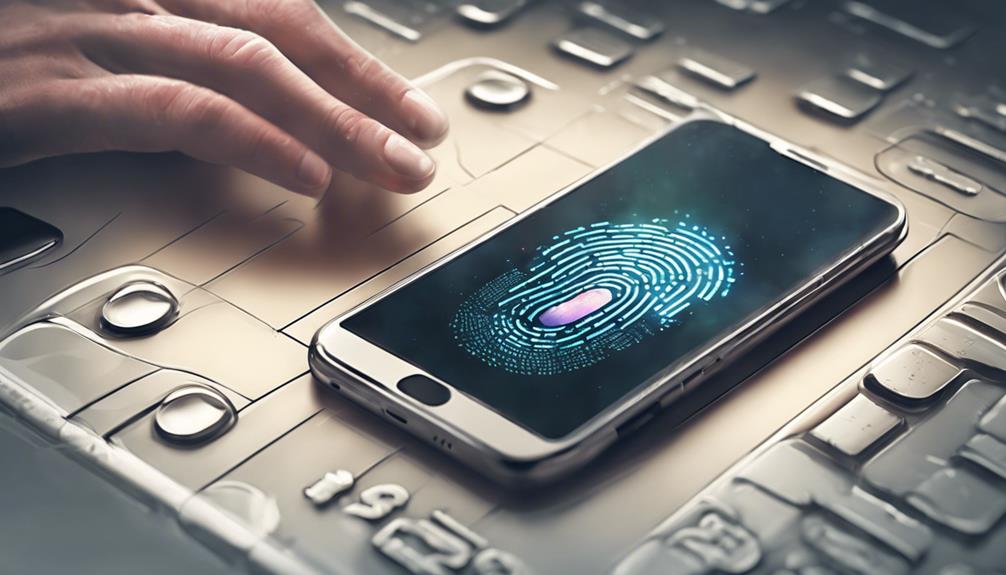To keep your mobile safe from hackers, implement strong security measures like setting up secure lock screens and downloading apps from reputable sources. Use a VPN on public Wi-Fi, enable remote tracking and wiping, and update your operating system regularly. Set strong passcodes and utilize biometric authentication. Be cautious with app downloads. Backup data frequently and avoid using public Wi-Fi for sensitive information. Staying informed about mobile security measures is essential. This all-encompassing approach guarantees your device is well protected against potential threats.
Key Takeaways
- Use strong security measures like VPNs and secure lock screens.
- Download apps from reputable sources and keep them updated.
- Enable remote tracking and wiping features for added security.
- Be cautious with public Wi-Fi; use a VPN and avoid sensitive activities.
- Stay informed on mobile security through expert advice and updates.
Secure Your Mobile Devices
Safeguarding your mobile devices through the implementation of strong security measures is crucial in protecting your personal information and sensitive data from potential hackers.
To enhance phone security, consider setting up a secure lock screen using a combination of strong passwords and biometric authentication methods. Additionally, only download apps from reputable app stores to reduce the risk of malware and hacking attempts.
Moreover, utilizing a Virtual Private Network (VPN) when connecting to public Wi-Fi networks can greatly strengthen your device's security. A VPN encrypts your data, making it more challenging for hackers to intercept sensitive information transmitted over the network. By enabling remote tracking and wiping features on your mobile device, you can also make sure that your data remains safe in the event of loss or theft.
Implementing these security practices will help fortify your mobile device against potential security breaches and safeguard your personal data from unauthorized access.
Update Operating Systems Regularly

To enhance the security of your mobile device, one critical practice is making sure that you update its operating system regularly. By keeping your operating system up to date, you can stay ahead of potential security vulnerabilities and safeguard your device against hacker exploits.
Here are some key reasons why updating your operating system is essential:
- Patch Security Vulnerabilities: Operating system updates often include crucial security patches that address known vulnerabilities within the system.
- Enhance Security Features: Regular updates ensure that your device is equipped with the latest security features to defend against hacking attempts.
- Reduce Cyber Threats: Neglecting updates leaves your device more vulnerable to cyber attacks, jeopardizing your personal information.
- Automate Update Checks: Setting your device to automatically check and install updates guarantees that you benefit from the most recent security enhancements.
Set Strong Passcodes and Biometrics

To improve the security of your mobile device, it is essential to set strong passcodes and utilize biometric authentication methods.
Strong passcodes should include a combination of numbers, letters, and symbols to create a complex barrier against unauthorized access.
Biometric authentication, such as fingerprint or facial recognition, offers an additional layer of protection by using unique biological characteristics for device verification.
Secure Passcodes Importance
Strengthening the security of your mobile device involves setting strong passcodes and utilizing biometric authentication methods. When it comes to securing your phone and its data, the significance of strong passcodes cannot be overstated.
- Strong passcodes act as the first line of defense against unauthorized access to your device and the sensitive information it holds.
- Biometric authentication methods like fingerprint or facial recognition provide an additional layer of security, enhancing the protection of your data.
- Combining strong passcodes with biometrics creates a robust security barrier, making it harder for hackers to breach your device.
- Avoid using easily guessable passcodes like '1234' or 'password' to prevent unauthorized individuals from gaining access to your phone.
Biometric Authentication Benefits
Implementing biometric authentication on mobile devices offers a robust layer of security beyond just using strong passcodes. Biometric authentication, such as fingerprint or facial recognition, provides a secure method of verifying users' identities. This unique identifier is challenging to replicate, greatly reducing the risk of unauthorized access to personal information stored on mobile devices.
By combining biometrics with strong passcodes, users can enjoy enhanced security measures that deter hackers effectively. Even if a passcode is compromised, biometric authentication acts as a safeguard against unauthorized access, ensuring that sensitive data remains protected.
Additionally, the convenience of biometric authentication makes it a popular choice among users, allowing them to access confidential information securely. Overall, the integration of biometric authentication in mobile security strategies not only enhances protection but also streamlines the user experience by offering a reliable and efficient security measure.
Password Management Tips
Enhancing mobile security involves implementing strong passcodes and utilizing biometric authentication methods like fingerprint or facial recognition to safeguard personal information effectively.
To guarantee robust password management, consider the following tips:
- Set strong, unique passwords with a mix of letters, numbers, and symbols to enhance security.
- Utilize biometric authentication methods like fingerprint or facial recognition for added protection.
- Avoid using easily guessable information like birthdays or names in your passcodes.
- Change your passwords periodically to reduce the risk of unauthorized access.
Additionally, consider using a password manager to securely store and manage all your passwords.
Be Cautious With App Downloads

Prioritize verifying app authenticity and checking developer information before downloading to safeguard your mobile device from potential security risks. When choosing to download apps, it is important to confirm they come from reputable sources such as official app stores.
Avoid obtaining apps from unknown sources or third-party websites, as these may harbor malicious software that can compromise your device's security. Additionally, carefully review the app permissions requested during installation and only grant access to the necessary functions to protect your personal data from unauthorized access.
It is essential to regularly update your apps to address security vulnerabilities and shield your device from emerging threats. For an added layer of protection, consider utilizing app reputation services or security software to scan and verify the integrity of the apps before installation.
Enable Remote Tracking and Wiping

Enabling remote tracking and wiping on your mobile device offers crucial benefits in safeguarding your data.
Remote tracking allows you to pinpoint your phone's location if it goes missing, providing an essential tool for recovery.
Additionally, the ability to remotely wipe your device guarantees that sensitive information remains secure, especially in emergency situations where theft or loss occurs.
Remote Tracking Benefits
Utilizing remote tracking and wiping capabilities on your mobile device enhances security measures by enabling GPS-based location tracking and data erasure features. This proactive approach helps safeguard your phone remotely, ensuring the protection of your privacy and sensitive information. By activating these security measures, you can efficiently manage the risk of unauthorized access to your personal data in case of theft or loss.
Here are some key benefits of remote tracking and wiping:
- Locate Your Device: With GPS technology, you can pinpoint the exact location of your phone remotely.
- Protect Sensitive Information: Remote wiping allows you to erase all data on your device to prevent unauthorized access.
- Prevent Data Breaches: Enabling these features helps to mitigate the risk of data breaches in the event of theft.
- Enhance Privacy: By utilizing remote tracking and wiping, you can maintain the privacy of your personal information even in challenging situations.
Wiping Data Remotely
To strengthen the security of your mobile device, activating the remote tracking and wiping features is essential to safeguard your data in case of theft or loss. By enabling remote tracking, you can locate your device if misplaced or stolen, while remote wiping allows you to erase data stored on the phone to prevent unauthorized access to your personal information.
This vital feature, available on both Android and iOS devices, provides a layer of protection against potential breaches of privacy. In the event of an emergency, the ability to remotely lock or wipe your device becomes crucial in safeguarding sensitive data.
Setting up remote tracking and wiping ensures that your personal data remains secure and inaccessible to malicious actors, reducing the risks associated with mobile theft or loss. It is paramount to activate these features to enhance the overall security of your mobile device and protect your privacy effectively.
Security in Emergencies
Activating the remote tracking and wiping features on your mobile device is crucial for enhancing security in emergencies. By enabling remote tracking, you can pinpoint the exact location of your phone through GPS technology, aiding in its retrieval if lost or stolen.
Simultaneously, remote wiping offers the ability to erase all data on your device, safeguarding sensitive information from unauthorized access. In times of crisis, these security measures play a crucial role in maintaining the integrity of your mobile device and protecting your personal data.
Utilize remote tracking to pinpoint your phone's location in emergencies.
Enable remote wiping to erase all data on your device and protect sensitive information.
Safeguard personal information from unauthorized access through these security measures.
Enhance the security of your mobile device by activating remote tracking and wiping features.
Backup Data Frequently

Regularly backing up your mobile data is essential in safeguarding against potential data loss due to hacking incidents or device malfunctions. Utilizing cloud storage services or external devices can help securely store your backups, ensuring that your essential data such as contacts, photos, and documents are protected.
Setting up automatic backups further enhances convenience and peace of mind, as it guarantees that your data is consistently and regularly saved without manual intervention. By backing up your data frequently, you not only protect yourself against potential hacking threats but also facilitate smooth changes to new devices.
In the event of data loss, having recent backups readily available can be a lifesaver. Remember, the key to effective data protection lies in the proactive approach of regularly backing up your essential information.
Avoid Public Wi-Fi Networks

Utilizing public Wi-Fi networks poses significant security risks that individuals should be aware of and actively mitigate to safeguard their sensitive data. When connecting to public Wi-Fi, it's important to exercise caution and follow best practices to minimize the chances of falling victim to cyber threats.
Here are some essential tips to help you stay safe:
- Avoid accessing sensitive information, such as online banking or personal accounts, while using public Wi-Fi.
- Hackers can set up fake Wi-Fi hotspots to steal data, so always verify the network with the establishment you are visiting.
- Using a VPN (Virtual Private Network) on public Wi-Fi adds an extra layer of security by encrypting your internet connection.
- Be cautious with personal information like passwords or credit card details when using public Wi-Fi to prevent potential hacking incidents.
Utilize VPN for Added Security

When safeguarding your mobile device against potential hacking risks, utilizing a VPN for added security is an important measure to protect your sensitive data on public Wi-Fi networks.
A virtual private network (VPN) encrypts your internet connection, ensuring that your online activities are shielded from hackers seeking to intercept your data.
By masking your IP address, VPNs add an extra layer of security, making it challenging for cybercriminals to track your online behavior.
The use of VPNs on mobile devices is essential for enhancing mobile security, especially when browsing or conducting transactions where sensitive information is involved.
Additionally, VPNs provide anonymity and data privacy, safeguarding your online activities from potential threats.
With VPNs, you can also access geo-restricted content securely, ensuring that your mobile data remains protected.
Stay Informed About Latest Threats

Remaining informed about the latest threats in mobile security is crucial for effectively safeguarding your device against potential hacking risks. Staying updated on emerging security issues guarantees that you can take proactive measures to protect your mobile data and prevent hackers from exploiting vulnerabilities.
To Stay Safe, consider the following:
- Stay Updated: Regularly check reputable cybersecurity websites and news outlets for the latest information on data breaches and security threats.
- Follow Experts: Engage with security experts and organizations on social media to receive real-time updates on potential risks that could compromise your device.
- Subscribe to Newsletters: Receive regular insights on mobile hacking techniques and ways to prevent hackers from stealing personal information by subscribing to security newsletters and blogs.
- Attend Events: Enhance your knowledge by attending webinars, workshops, and conferences focused on mobile security to stay ahead of current threats.
Frequently Asked Questions
Can I Prevent My Phone From Being Hacked?
Preventing hacking on your phone involves implementing security measures like using strong passwords, enabling two-factor authentication, avoiding untrusted app sources, updating software regularly, being cautious on public Wi-Fi, and understanding remote locking features for data protection.
How Do I Make My Phone More Secure?
To enhance mobile security, implement biometric authentication, update software, avoid unofficial app sources, use strong passwords, and manage permissions wisely. These practices fortify your device against potential threats, safeguarding your personal information and digital assets.
Can You Check to See if Your Phone Is Hacked?
To determine if your phone is hacked, monitor for unusual activity, check for rapid battery drain, review your phone bill for unexpected charges, run security scans with trusted antivirus software, and, if suspicions persist, change passwords and activate two-factor authentication.
Can You Remove a Hacker From Your Phone?
Similar to evicting an unwelcome guest, removing a hacker from your phone requires immediate action. Disconnect from the internet, contact your mobile service provider, reset to factory settings, change passwords, and enable two-factor authentication for enhanced security.
Conclusion
In summary, it is essential to take proactive steps to protect your mobile devices from hackers. By securing your devices, updating operating systems regularly, setting strong passcodes, being cautious with app downloads, enabling remote tracking and wiping, backing up data frequently, avoiding public Wi-Fi networks, utilizing VPN for added security, and staying informed about the latest threats, you can greatly reduce the risk of falling victim to cyberattacks.
As the saying goes, 'prevention is better than cure.'









